A wireless solution.
Headphones? What’s that doing here? Well, show me someone not interested in music and the movies and I’ll show you one who cannot take a photograph.
One of the cheapest – yet most vital – components of my HackPro desktop is the extremely thin layer of conducting Arctic Silver thermal paste between the case of the Core2Quad CPU and the Coolermaster radiator which keeps the CPU cool as a cucumber. The maker of that paste, beloved of all computer builders, also makes headphones.
For a long while now I have been using a pair of Sennheiser PX100 corded headphones for listening to music and watching movies on the iPhone and iPad. They are over the ear, comfortable and the sound is fine. They cost $60-70. Folding them into the provided clamshell case requires a degree in astrophysics, but once you get the hang of it there’s lots of innocent fun to be had and money to be made betting friends they can’t get them into the case! Indeed, I just had the satisfaction the other week of taking $2 off our nine year old who quit in frustration. One back for the old man!
But that bet cost me, as somehow the cord got frayed and is now literally hanging by a thread. So I searched around for a wireless alternative which might better survive our boy’s ministrations, and settled on the Arctic Sound P311 at $30, a Bluetooth headphone which requires no wired connection.
The manufacturer claims a 20 hour life per charge, and charging is through the provided USB cable from any computer, so there’s no additional charger to carry. All you need is the mini-USB cable and your laptop or desktop. The iPad’s battery life on streamed Netflix movies is a consistent 11 hours, so as long as the headphones’ battery lasts 11 hours or more things are fine. Charge the iPad, charge the ‘phones. My ‘phones shipped partially charged, needing just 90 minute to full charge, indicated by the red charging LED being extinguished. The maker says a full charge takes 2 hours. The bottom line is that a 2 hour charge to get 20 hours of use is far faster and longer than recharging an iPad will get you, so the iPad remains your limiting factor in practical use as far as recharging goes.
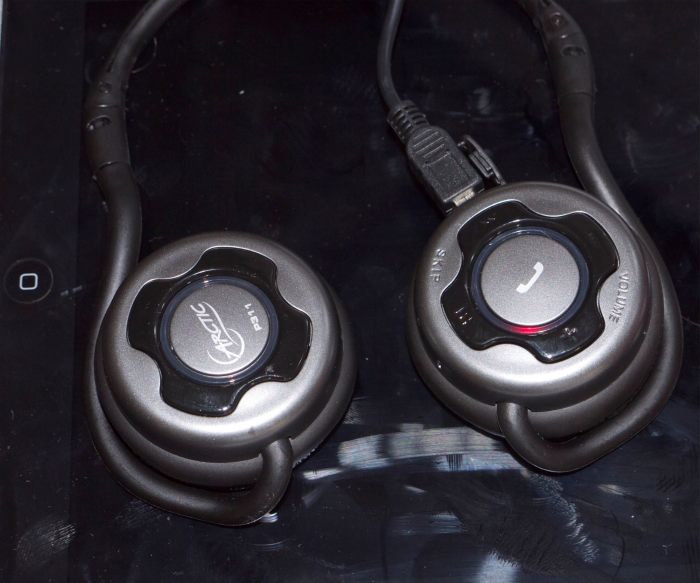
Charging light on. This changes to alternating red/blue when pairing – see below.
My primary use is for iPad movies, but the ‘phones work fine with my rather dated iPhone 3G, my HackPro (which uses an iOGear BT dongle), the MacBook Air and the MacMini used as a home theater computer. The latter is handy as you can listen to movies on your big screen TV using these Bluetooth headphones, and disturb no one during a spot of late night viewing. On the iDevices pairing is simply a question of holding down the button on the right headset for a few seconds until you get alternating red and blue LEDs, then going to Settings->General->Bluetooth. On desktops and laptops you go to System Preferences-> and have at it. In all cases, disconnect the existing Bluetooth connection or things get hairy and be sure you are not charging the ‘phones while you do this – I had no luck pairing while charging.
Here are some screenshots of the pairing process.
Pairing on an iDevice:

Step 1

Step 2
Select the Eq which suits your ears best – forget what it’s called, go with your ears:
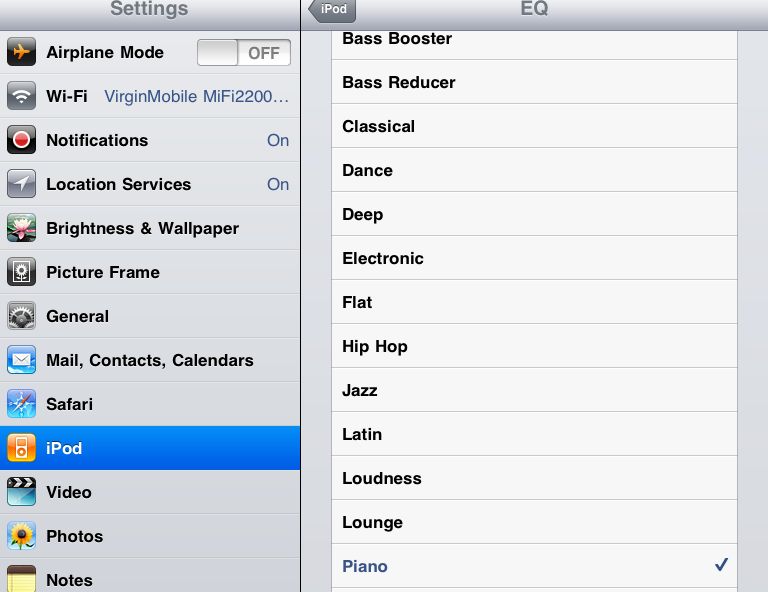
Step 3
Pairing on a laptop or desktop:
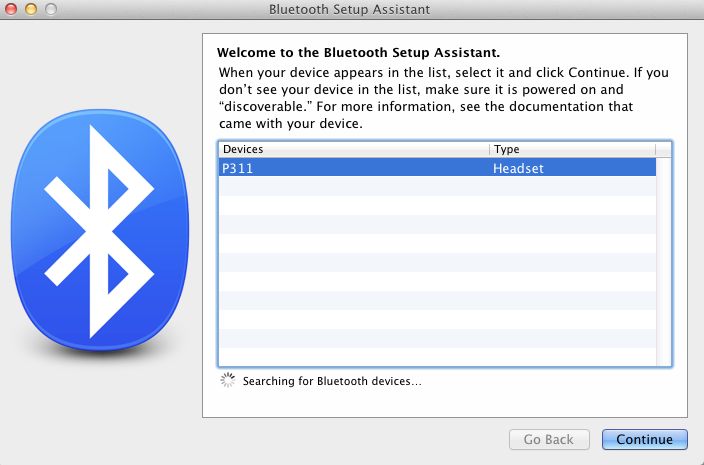
Step 1 – System Preferences
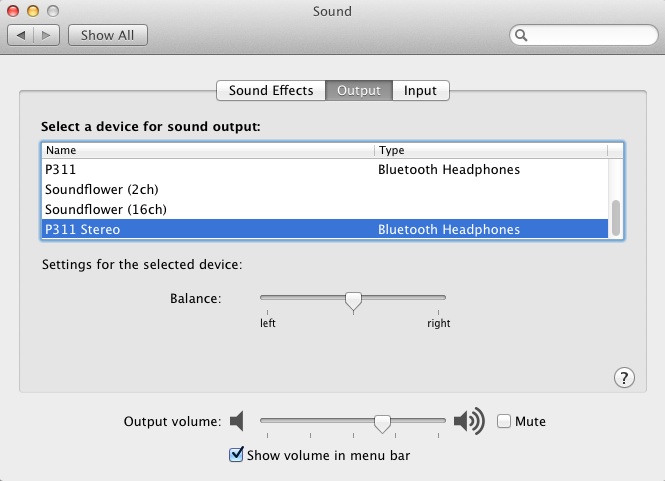
Step 2 – Paired.
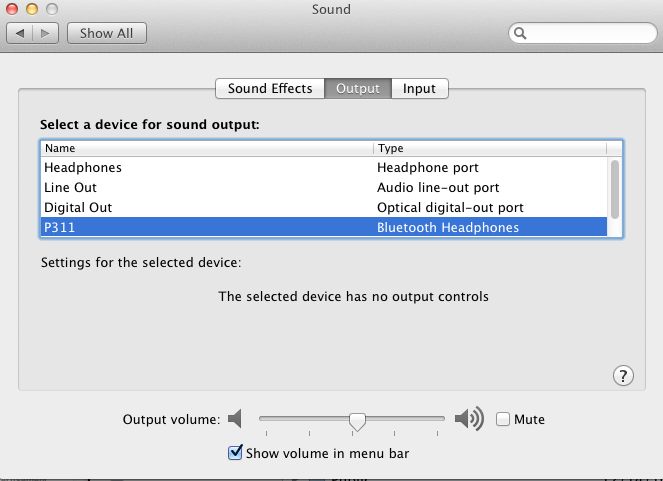
Step 3. System Preferences->Sound. Redirect the output to the headphones.
Use with AppleTV2:
As TUAW confirms, ATV2 includes a Bluetooth chip but it is not accessible in the device as shipped. Frustrating. You can hack your ATV2 to make BT work but it’s likely that future software updates will reverse the hack, so I’m leaving it alone for now. Hopefully Apple will add a Bluetooth switch in its ATV2 software. Meanwhile, rumors suggest that the next ATV OS update will add Bluetooth functionality to ATV2. That will be great if it happens.
These ‘phones fit over the ear (Van Gogh need not apply), like the Sennheisers, but rather than using a sprung steel band across the top of your head to provide grip, they hook over each ear instead with the connecting band serving no mechanical purpose other than connecting the two speakers and providing a route for the wire buried within, to get sound to both ears.
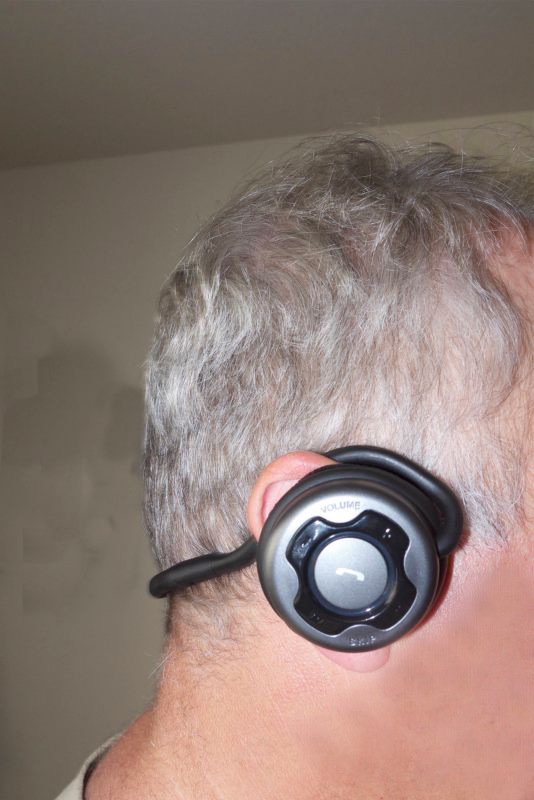
The P311 headphones over the ear, showing the controls.
No problem when wearing glasses, either.

The volume control buttons are visible above; the other two black buttons are for fast forward and reverse (next/previous track) and the center button is on/off/pause/answering phone calls. All controls worked perfectly with the iPod app on my iPhone and iPad.
The P311s comes with a nice, semi hard case. The earspeakers are folded in eyeglasses-style, and the astrophysics degree you just got to put away your Sennheisers is now useless:
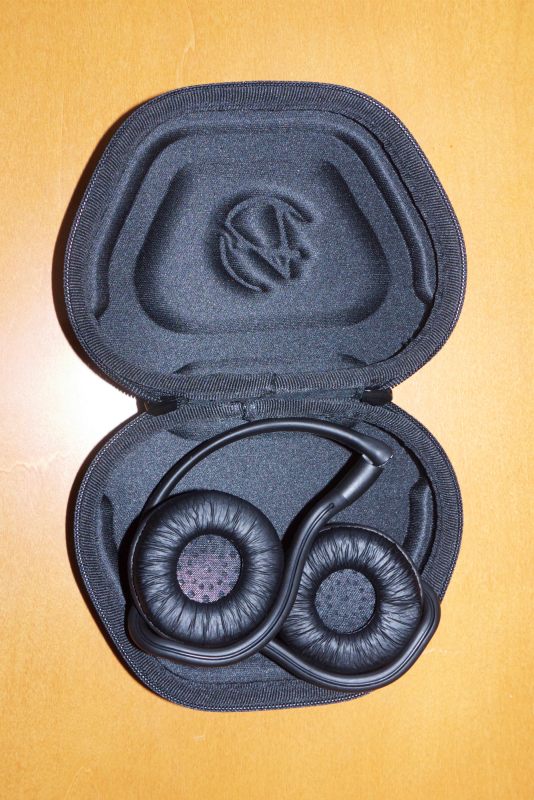
Sound: I tested the ‘phones on classical piano and on Ken Russell’s extraordinary movie ‘Mahler‘. The sound is excellent. You won’t get earth shaking bass from speakers this small (especially given their low level of sealing to the ear) but experimenting with the EQ settings in an iDevice (see above) gets you the best sound, based on your hearing. Both the iDevice and P311 volume controls remain functional so you can mute from either. Pausing using the big, central button on the right speaker also pauses the movie or iPod on your iDevice.
Despite fitting lightly over the ears, these provide a fair amount of sound isolation. You are not sealed from the outside world but there is a significant amount of noise reduction. Best as I can tell there is no electronic noise cancellation technology in the P311s.
Comfort: If you tilt your head back the crossbar will strike the base of your neck and try to displace the ‘phones. Whether that’s an issue only you can decide. In practice it suggests these ‘phones may be sub-optimal for aggressive work out routines. The picture of the acrobat on Arctic’s web site strikes me as ludicrous.That’s not what I use them for so I cannot comment.
Microphone: There’s a built-in mic for use with the iPhone. I have not tested it.
Range: Extraordinary. There is no loss of signal until you are over 40 feet from either iPad or iPod, despite intervening walls and a staircase. This translates, in practice, into ‘walk-about’ functionality in the average home without having to take your sound source with you
A fine set of phones at a great price and a worthy replacement for my damaged Sennheisers. There’s the inconvenience of having to recharge these, but as their battery life exceeds that of the related iPad I use them with, it’s hardly an issue, as I simply recharge both simultaneously. BT pairing on the five devices I tested – iPhone 3G, iPad, HackPro, MacMini and MacBook Air was flawless. Let’s hope pairing with the AppleTV2 arrives with the next ATV OS update. Recommended, but try them first to see if they are comfortable for you.
Most importantly, cordless ‘phones transform an iPad from “I’m not going to lug that around” to a functional music source, whether from stored music, your Home Sharing or, soon the iCloud.